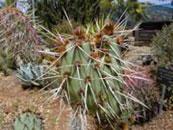Leaves for extreme climates
Read the information in the box below about the jobs leaves do for plants.
|
Leaves do three main important jobs for plants:
|
- Read the information about the leaves and the plant that they come from;
- Describe how the special features of the leaves help that plant survive in its environment
(The first one is done for you.)
| a) |
 |
Where the plant is adapted to grow: In cold snowy places. |
| Description of the leaves: The leaves are long and thin with a waxy coating. There are a lot of them. | ||
How the special features of the leaves help the plant grow in cold snowy places:
|
- Growing in the forest (L2/4)



 Picture source: Wikipedia
Picture source: Wikipedia| Y6 (08/2006) | |
| a) |
(Answer provided) There are lots of leaves so the tree can make food even though the leaves are small and there is not a lot of sunlight. or The waxy coating helps save water when the tree can't get water from the frozen ground. |
| b) |
Best answer (very difficult) Answer includes reference to both sun/light and making food.
Partial answer acceptable at this level (difficult)
|
| c) |
Best answer (very difficult) Answer includes being on top of the water so it can catch enough sunlight to make food and/or breathe.
Partial answers acceptable at this level (moderate)
Answer makes reference to sunlight or breathing only.
or
Answer makes reference to floating.orAnswer makes reference to waterproofing.
|
| d) |
Best answers (very difficult)
Relates function of the leaf to surface area and/or water retention
or
Answer includes reference to protection and water stored in the plant.
Partial answers acceptable at this level (difficult)
Answer makes reference to protection only.
or
Answer mentions water without reference to leaves.
or
Answer implies preventing dehydration, but either does not explain how, or explanation includes a misconception.
or
Answer makes reference to the sun (beginning to explain the relationship between too much sun and the reduced leaf area).
|
Strategies to assist students experiencing language difficulties
The task includes two specialist science words that may cause problems for some students:
Particular attention should be paid to discussing these words, especially with ESOL learners, or learners with limited vocabulary, but it is worth checking that all students are familiar with their meaning in this context.
Common misconceptions
| Common response | Likely misconception | Science view |
| Water is gained through the leaves (37 students). | Confusion about which part of the plant absorbs water | Roots absorb water and nutrients. |
| Leaves suck up water (3 students) | The misconception could be the same as above. | Water rises through the roots, up the stem and out through the leaves. |
| Large leaves provide shade for the plant (12 students). | Consider that the leaves protect the plant from the sun. | Sunlight is scarce so the leaves need to have a larger surface area to take advantage of what sun does reach them. |
|
(The cactus) does not need much/any water (8 students). (The fern) does not need sun (1 student). |
Interprets the adaptation as meaning that the plant does not need water/sun, rather than an adaptation to overcome a lack of water/sun. NOTE: Because of these adaptations, plants may not do well in opposite conditions such as very wet (cactus) or very sunny (fern). |
All plants need sunlight to make food, and water to transport food and minerals around the plant. Some plants have adaptations to ensure the plant has strategies for gathering more sunlight or conserving water. |
Functions of leaves
More students used the information that leaves use sunlight to make food than the other functions of respiration and transpiration.
Addressing misconceptions about functions of leaves
At this level students are not expected to know the mechanics of the functions of plants in great detail. Much of the information can be accessed from books, but some practical activities will help to demonstrate the functions.
| Important understandings for Levels 3 and 4 | Activities |
| Green plants use sunlight to make their food, and this mostly happens in the leaves. (Students do not need to be able to explain photosynthesis.) |
Refer to BSC Book 63, Growing plants indoors, Activity 2, pages 9 and 10 for more details. |
| Water is taken up through the roots, and is lost through the leaves. | This can be demonstrated by tying a plastic bag over a leaf, and observing the water collected. |
| Plants "breathe" through little holes in their leaves. (Roots also take in air from the soil.) | Use a magnifying glass to look for the stomata (holes). |
- If there is not much sun where a plant is growing, what might it need so it is able to make enough food?
- Why do you think the size of some trees' leaves change as they get taller?
- Investigate leaves of plants growing in the lower canopy. Is there a pattern? What other strategies do plants use to get sunlight (e.g., tendrils for climbing)?
- Ask students to think about how all the parts of a plant work together, e.g., a cactus has long roots to collect water deep underground, stores water in its stems, and has reduced leaves to prevent losing too much water. All the parts work together to overcome the lack of water in dry conditions.
- Plants and where they grow (Level 3)
- Science quiz (Levels 2/4)
- Design a plant (Level 3) This resource asks students to design a plant that lives in a dry climate. It could be adapted to address other conditions.
- Growing in the forest (Levels 2-4)
Ministry of Education (2004). Building Science Concepts Book 63. Growing plants indoors. Wellington: Learning Media.

